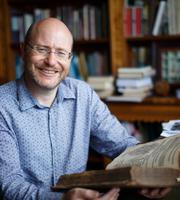In 1803, the first of almost 73,000 convicts landed on what was then called Van Diemen’s Land. Over the course of the next 50 years convict clerks kept meticulous records of each new arrival in leather-bound volumes. Pouring over the voluminous ‘black books’, researchers can determine whether a convict could read or write, how much money they had in their bank account and in some cases, the species of worm that infested their gut.
Professor Hamish Maxwell-Stewart’s team is using these records to piece together an elaborate intergenerational picture of Tasmanian settler society, in order to explore the impact of penal servitude on the lives of convicts, their children and grandchildren.
As it turns out, the men and woman sent to Tasmania ‘for their country’s good’ are among the best-documented citizens of the 19th-century’s British Empire, Professor Maxwell-Stewart said.
“Women are frequently absent from most historical archives, but Tasmania is something of an exception to the general rule – 13,000 women were sent here as convicts. There is no other society that possesses such detailed records for such a large proportion of its founding mothers.
“We are able to see which convicts didn’t reoffend; those that had subsequent brushes with the law and the cases where children followed in their footsteps through the penal system. Combined with their full histories, we can begin to identify patterns of behaviour and key linkages between each of their stories.”
The project brings together historians, genealogists, demographers and population health researchers as well as a team of volunteers all working to study, transcribe and photograph the records.
“There has been a relatively stable population in Tasmania since it was colonised, meaning that in many instances we can trace family history through to the present day, and see how a convict’s history has impacted on their descendants.
For instance, we have identified a link between the height difference between the children of convicts and the children of free labourers. Convict children tended to be taller, which appears to be because convicts often had smaller families and fewer mouths to feed.
Bit by bit, the Founders and Survivors team has reassembled online the bureaucratic infrastructure used to run the Tasmanian penal colony.
When completed, they will have created an electronic panopticon enabling anybody to follow Tasmanian’s founding mothers and fathers from birthplace to colonial grave.
Find this research inspiring? Apply now to become a research student.
Find out more about the University of Tasmania's world-class research.
